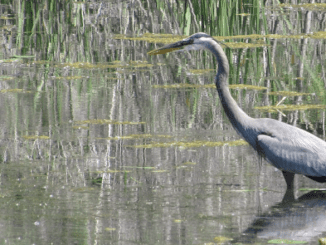
TRENTON, New Jersey, September 26, 2021 (ENS) – New Jersey’s native Atlantic white cedar forests have been harmed by climate change, suffering sea-level rise and storm surge that sent saltwater flooding into these fragile freshwater ecosystems, leaving ghost forests where thriving Atlantic white cedars once stood.
As part of New Jersey Governor Phil Murphy’s strategy to ensure the state grows more resilient to climate change, the Department of Environmental Protection will restore 10,000 acres of globally threatened Atlantic white cedar forests to the state’s Pinelands region, Commissioner Shawn LaTourette announced Tuesday as part of the state’s recognition of Climate Week.
“This is the largest forest restoration project ever undertaken in New Jersey and the largest ever in the nation restoring Atlantic white cedars,” Commissioner LaTourette said.
“Through this project, we will reestablish once-dominant stands of Atlantic white cedar, but at higher elevations less vulnerable to rising seas and saltwater intrusion and provide habitat for globally rare plants and wildlife, while capturing and storing carbon and absorbing floodwaters,” the commissioner explained.
The DEP’s Forest Service has had success in returning Atlantic white cedar to sites where the trees were lost on both public and private land.
DEP will now scale up this effort, returning more than 10,000 acres of cedar forests over 10 years to New Jersey’s Pinelands in places where its continued survival is not threatened by a changing climate.
Atlantic white cedar forests provide many ecological services including tremendous benefits to the hydrology and water quality of the Pinelands, a region specifically protected for its ground and surface water resources, says the New Jersey Department of Environmental Protection.
Underlying much of the Pinelands is the Kirkwood-Cohansey Aquifer, a vast reservoir estimated to contain over 17 trillion gallons of some of the purest water in the country. Adjacent counties and municipalities rely on clean and plentiful water flowing from the Pinelands.
Atlantic white cedar once occupied 500,000 acres in its range along the East Coast, from Maine to the Gulf states. Now less than 125,000 acres remain. In New Jersey, Atlantic white cedar occupied over 125,000 acres historically, but that area is now down to less than 25,000 acres.
The state’ tree-planting effort will strengthen connectivity of this ecosystem, increase the area of high-value wetlands that store and naturally filter water, create natural breaks needed for wildfire control – and begin to restore the grandeur of southern New Jersey’s wetland forests.
To view an Atlantic white cedar restoration video, visit http://atlanticwhitecedar.nj.gov/
The restoration will take place on state-owned forests, parks, and Wildlife Management Areas and is funded through DEP’s natural resource damage recoveries, including settlements with manufacturers and distributors of gasoline containing methyl tertiary butyl ether (MTBE) that contaminated groundwater and surface water throughout New Jersey.
Past logging has contributed to the decline of Atlantic white cedars. Disease and pest-resistant, cedar wood was valued for the construction of ships, shake roofs, clapboard, and fences.
Ditching, draining of wetlands, deer browsing and dam-building by a rebounding beaver population also contributed to the species’ decline..
In addition, Atlantic white cedar, though a coastal species, is not salt-tolerant. New Jersey has lost large tracts of these forests in areas impacted by steady sea-level rise as well as by storm surge along creeks and rivers, particularly during Superstorm Sandy in 2012. The impacts of sea-level rise have left dead forests known as ghost forests for their craggy and bleached-white appearance.
Yet the Atlantic white cedar forests serve as efficient carbon sinks, collecting atmospheric carbon and storing it throughout the tree and in the organic peat soil that these forests generate.
These forests provide unique habitat and are critical in maintaining the excellent water quality of the Pinelands as they filter, cool and slow the movement of ground water and streams.
“The grand Atlantic white cedars, like the pines and oaks, have characterized the natural landscape in the Pinelands for thousands of years,” said Richard Prickett, chairman of the New Jersey Pinelands Commission.
“Today we again need to depend on the majestic cedars, not to build objects from their wood, but to grow wood to help remove and store the carbon dioxide that the success of our forefathers has generated,” Prickett said. “With our help, the Atlantic white cedar can once again grow abundantly in the Pinelands and benefit humanity.”
The New Jersey Forest Service has led a years-long stakeholder process to identify and prioritize suitable areas for Atlantic white cedar restoration on state-owned property and has been working closely with municipalities and stakeholders since 2018.
“Restoration of Atlantic white cedar forests will fight climate change by sequestering large amounts of carbon in trees and restoring deep soil carbon in sphagnum peat for thousands of years,” said Jay Watson, senior director for Statewide Land Protection for the New Jersey Conservation Foundation.
“Atlantic white cedar forests also provide a unique habitat for rare Pine Barrens plants and animals in need of protection,” Watson said. “We applaud the NJDEP for these ambitious restoration efforts and look forward to working with them to advance this important project and other natural climate solutions.”
In addition to numerous municipalities, the DEP has worked with more than 60 stakeholder groups like the New Jersey Conservation Foundation, including environmental groups such as the Pinelands Preservation Alliance, and New Jersey Audubon.
“New Jersey Audubon supports this ambitious effort by the State, as Forest Stewardship Planning and active ecological forestry practice implementation,” said John Parke, Stewardship Project Director for NJ Audubon. “Atlantic white cedar restoration inherently provides enormous ecological uplift in a globally recognized Biosphere that is the New Jersey Pinelands.”
In addition to the state’s efforts, New Jersey Audubon is working with two private landowners to clear competing species, build fences to keep browsing deer away from the cedars, and plant seedlings where a stand of the trees needs help. The program will cover about 100 acres of private land in the Rancocas Creek and Maurice River watersheds.
A Delicate Balance: Restoring a Globally Rare Ecosystem
Atlantic white cedar depends on damp, acidic soils found along rivers, streams, bogs and wetlands. Mature forests form dense stands that allow little sun to penetrate to the forest floor. This shade-shrouded ecosystem fosters growth of sphagnum-moss hummocks, liverworts, ferns, insect-eating plants, and rare orchids, some found only in the Pinelands.
This unique ecosystem supports rare animal species, such as the Pine Barrens tree frog, barred owl and timber rattlesnake. These forests filter and purify water, stabilize stream banks, store stormwater and create natural breaks that can slow or halt the spread of wildfires.
The first phase of restoration is targeted to begin in late 2022 and encompass 2,000 acres along river headwaters in western Wharton State Forest.
The projects will restore a more natural mix of forest types, providing habitat for a greater variety of plant and animal species.
Restoration areas will vary from more than 20 acres each to parcels of several hundred acres. Priority will be given to connecting existing stands of cedars. Careful attention will be paid to conditions such as soils and hydrology. Any areas that could be impacted by saltwater from storm surge have been mapped and will be avoided.
Stands of competing hardwoods, such as red maple and black gum, that have taken over formerly cedar-dominant areas will be removed.
“Atlantic white cedar forests are very special places, and you know it as soon as you step into one,” said Carleton Montgomery, executive director of the Pinelands Preservation Alliance. “They are quiet, sublime and magnificent. Restoring these forests on a landscape level to the Pinelands will certainly provide a great many benefits to the region’s ecological diversity. But restoring these forests will provide many intangible benefits as well, as places for people to enjoy the simple grandeur of nature for many generations to come.”
Featured image: Atlantic white cedar trees killed by beaver flooding. The flooding has since receded making the area ready for restoration. (Photo courtesy New Jersey Fish and Wildlife)



